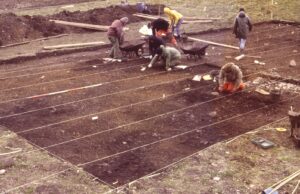
Mesolithic sites rarely make glamorous excavations. All too often they seem to comprise a corner of a muddy field where there is little to be seen except for a strange pattern of discolourations in the subsoil, and possibly some accumulations of broken stone. I spent much of my early career crouching down to investigate the fascinating archaeological remains that indicate the location of a Mesolithic settlement or activity site. I was lucky, many of the sites I have worked on were single period sites, preserved beneath a thin skim of ploughsoil. Visitors would be surprised how little overburden lay between the detritus of 8000 years ago and the present day. The survival of Mesolithic archaeology is often dependent on a fragile skin of ploughsoil or sediment.
We might come across a site during fieldwalking, when someone noticed a spread of characteristic microliths in the surface of a ploughed field. Other sites were noted by the farmer; local dog walkers or ramblers might spot the flints eroding out of sand dunes or at the edge of a loch or river. You can’t excavate every site but sometimes we would be lucky enough to raise money and put together a research design. The ploughsoil would be carefully peeled back, perhaps with the aid of a small mechanical digger, and a sample of the sediments would be sieved in order to identify and remove the precious fragments of worked flint and other stone that denoted Mesolithic activity. Working to remove the bottom of the ploughsoil would take place by hand, using an excavation trowel in order to clean the surface of the subsoil and expose the pits and post holes that provided vital indications of prehistoric activity.
Once down into these in situ remains then excavation takes place more slowly. Surfaces have to be carefully cleaned and small finds of flint or other stone are recorded in place before they are bagged and sent to the finds hut for packing and further analysis. Excavation like this allows the locations of post holes, pits, hearths and other features to be recorded and planned so that it is possible to work out the original positions of huts, shelters and all the ephemera of everyday life. Accumulations of worked flints can indicate the positions of activity areas where people were making tools or processing hides and other tasks. The soil that fills the features is carefully sampled and sieved so that the process of unpicking Mesolithic life can begin. Fills like this may contain traces of pollen, insects, and other matter that provide vital clues to things like local vegetation and the environment.
Excavation is only the first part of a long process that involves analysis by many different specialists. Careful record keeping allows full detail of the excavated site to be reconstructed, but for every month of fieldwork, it may be several years before the results of the investigation are ready to be published. It is interesting to see how people made use of the resources available to them. Stone tools can be examined for information relating to the raw material, manufacturing techniques, types of tools made and even the uses to which those tools were put. Everything adds to the picture of Mesolithic life. It is rare to find traces of organic material on a Mesolithic site, but charcoal and carbonized nutshell can survive. These can help with dating the site using radiocarbon dating, as well as with the investigation of local woodland and plants.
On occasion a special type of Mesolithic site, known as a shell midden, will be excavated. These exciting sites comprise the remains of rich waste heaps where the presence of large quantities of shell create a good environment for the preservation of the sort of material, such as bone, that usually decays elsewhere. Excavation of a shell midden is slow and painstaking, but it can reveal a lot of information about diet and even the manufacture and use of bone and antler tools such as harpoons and spear points.
Because our Mesolithic ancestors did not build permanent structures or monuments, their sites rarely contain upstanding remains. A series of shell midden sites on the island of Oronsay in the Inner Hebrides provide an exception to the rule because they comprise great mounds of midden material that once stood well above head-height. These sites were created towards the end of the Mesolithic, around the time that the first farmers were creating small farms and settlements around the coasts of Scotland. Oddly they are also some of the only Mesolithic sites to contain human remains, albeit only in very small quantity. We still do not know precisely how the Mesolithic community in Scotland disposed of their dead.
Mesolithic excavation continues around the country. As excavation techniques advance, so every new site reveals new detail of Mesolithic life. In recent years there has been more evidence relating to the houses, often quite large round structures, that were built. Other sites have helped us to understand links between different parts of Scotland as different types of stone were transported from one place to another to make arrowheads and flakes. In Aberdeenshire a series of new sites has added detail to our knowledge of hunting strategies, both in the uplands of the Cairngorms and with a series of pits for hunting deer in the lowlands. It may not be glamorous work, but for those with an interest in the past there is nothing like getting down and dirty and sifting out the evidence for yourself.
You must be logged in to post a comment.